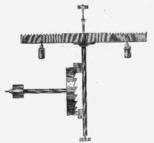clock
The word clock derives from the medieval Latin word for 'bell'—clogga—and has cognates [同源词] in many European languages. Clocks spread to England from the Low Countries, so the English word came from the Middle Low German and Middle Dutch Klocke. 低地国家是对欧洲西北沿海地区的称呼,广义上包括荷兰、比利时、卢森堡,以及法国北部与德国西部,狭义上则仅指荷兰、比利时、卢森堡三国,合称“比荷卢”或“荷比卢”。
A clock is a device used to measure, keep, and indicate time. The clock is one of the oldest human inventions, meeting the need to measure intervals of time shorter than the natural units: the day, the lunar month, and the year. Devices operating on several physical processes have been used over the millennia.
In lunar calendars, a lunar month is the time between two successive syzygies of the same type: new moons or full moons. The precise definition varies, especially for the beginning of the month. Syzygy is either of the two positions (conjunction or opposition) of a celestial body when sun, earth, and the body lie in a straight line.
Some predecessors to the modern clock may be considered as "clocks" that are based on movement in nature: A sundial shows the time by displaying the position of a shadow on a flat surface. There is a range of duration timers, a well-known example being the hourglass. Water clocks, along with the sundials, are possibly the oldest time-measuring instruments. A major advance occurred with the invention of the verge escapement, which made possible the first mechanical clocks around 1300 in Europe, which kept time with oscillating timekeepers like balance wheels.
The verge (or crown wheel) escapement is the earliest known type of mechanical escapement, the mechanism in a mechanical clock that controls its rate by allowing the gear train to advance at regular intervals or 'ticks'. Its origin is unknown. Verge escapements were used from the late 13th century until the mid 19th century in clocks and pocketwatches. The name verge comes from the Latin virga, meaning stick or rod. 边缘(或冕状轮)擒纵机构是已知最早的机械擒纵机构,是机械钟中的一种机构,通过允许齿轮系以固定间隔或“滴答”前进来控制其速度。其来源未知。13世纪末至19世纪中期,钟表和怀表中使用了边缘擒纵装置。verge这个名字来自拉丁语virga,意思是棍棒。

Traditionally in horology, the term clock was used for a striking clock, while a clock that did not strike the hours audibly was called a timepiece; this distinction is no longer made. Watches and other timepieces that can be carried on one's person are usually not referred to as clocks. Spring-driven clocks appeared during the 15th century. During the 15th and 16th centuries, clockmaking flourished. The next development in accuracy occurred after 1656 with the invention of the pendulum clock [摆钟] by Christiaan Huygens [惠更斯]. A major stimulus to improving the accuracy and reliability of clocks was the importance of precise time-keeping for navigation. The mechanism of a timepiece with a series of gears driven by a spring or weights is referred to as clockwork; the term is used by extension for a similar mechanism not used in a timepiece. The electric clock was patented in 1840, and electronic clocks were introduced in the 20th century, becoming widespread with the development of small battery-powered semiconductor devices.
The study of timekeeping is known as horology. A timepiece is a clock, watch, or other device that measures and shows time.
The timekeeping element in every modern clock is a harmonic oscillator [谐振子], a physical object (resonator) that vibrates or oscillates at a particular frequency. This object can be a pendulum, a tuning fork, a quartz crystal, or the vibration of electrons in atoms as they emit microwaves. 做简谐振动的质点即谐振子。简谐振动:物体在与位移成正比的恢复力作用下(如弹簧的弹力),在其平衡位置附近按正弦规律作往复的运动。
oscillate和vibrate的区别(三种说法):
- oscillate: to move backward and forward; to vibrate like a pendulum; to swing; to sway.
- As verbs the difference between oscillate and vibrate is that oscillate is to swing back and forth, especially if with a regular rhythm while vibrate is to move with small movements rapidly to and fro.
- Oscillation can be seen in the swinging of a pendulum clock and vibration in the plucking of guitar string. Difference Between Oscillation and Vibration
Clocks have different ways of displaying the time. Analog clocks indicate time with a traditional clock face [钟面], with moving hands [移动的指针]. Digital clocks display a numeric representation of time. Two numbering systems are in use; 24-hour time notation and 12-hour notation. Most digital clocks use electronic mechanisms and LCD, LED, or VFD [vacuum fluorescent display] displays. For the blind and use over telephones, speaking clocks state the time audibly in words. There are also clocks for the blind that have displays that can be read by touch.
六级/考研单词: derive, medieval, interval, lunar, physics, calendar, conjunction, successor, shade, duration, verge, gear, regulate, tick, rod, flourish, pendulum, navigate, patent, electron, vibrate, tune, fork, crystal, atom, emit, microwave, backward, swing, sway, verb, differentiate, rhythm, rapid, digit




 浙公网安备 33010602011771号
浙公网安备 33010602011771号